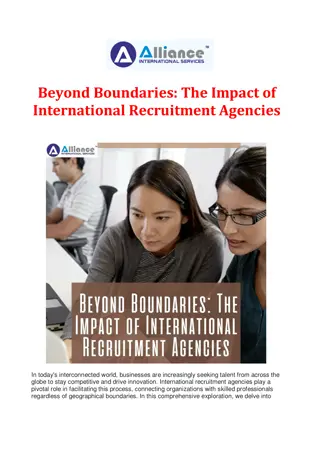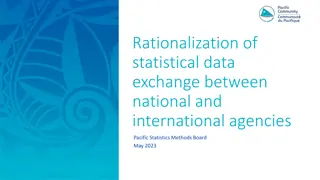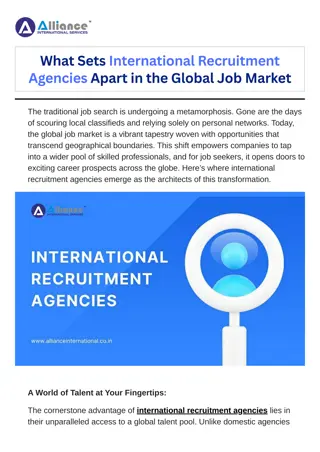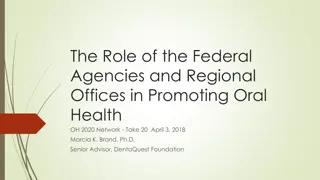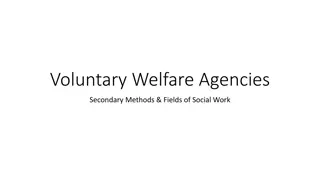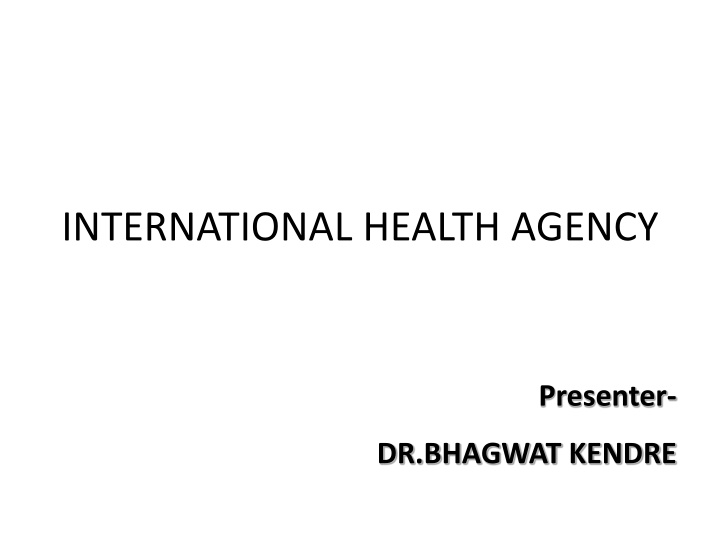
Evolution of International Health Agencies
Health and disease transcend political and geographical boundaries, necessitating international cooperation. This has led to the development of a network of public health units, ranging from local to global organizations like the World Health Organization. Explore the history and functions of various international health agencies, including multilateral, bilateral, and non-governmental organizations.
Download Presentation

Please find below an Image/Link to download the presentation.
The content on the website is provided AS IS for your information and personal use only. It may not be sold, licensed, or shared on other websites without obtaining consent from the author. If you encounter any issues during the download, it is possible that the publisher has removed the file from their server.
You are allowed to download the files provided on this website for personal or commercial use, subject to the condition that they are used lawfully. All files are the property of their respective owners.
The content on the website is provided AS IS for your information and personal use only. It may not be sold, licensed, or shared on other websites without obtaining consent from the author.
E N D
Presentation Transcript
INTERNATIONAL HEALTH AGENCY Presenter- DR.BHAGWAT KENDRE
CONTENTS Introduction Historical considerations Basic considerations United nations agencies WHO & oral health UNICEF Food and Agriculture Organization International Labour Organization & World Bank Bilateral agencies Non governmental and other agencies Voluntary health agencies Health agencies of India Health agencies for dental care Conclusion References
Introduction Health and disease have no political or geographical boundaries. Disease in any part of the world is a constant threat to others. So, it is increasingly being recognized as a matter which requires international cooperation. To end this, a vast network of public health units has evolved. The smallest of these cater to the health needs of small rural areas: the largest, the World Health Organization, concerns itself with the entire world.
International health organizations Are of three types: Multilateral: Funding comes from multiple governments and is distributed to many different countries. The major multilateral organizations are all part of the United Nations Example: World Health Organization. Bilateral: Bilateral agencies are governmental agencies in single country which provide aid to developing countries NGOs: Non-governmental organizations (NGOs), also known as private voluntary organizations (PVOs). Example: Rockefeller foundation, Ford foundation
Pan American Sanitary Bureau (1902) It was primarily intended to coordinate quarantine procedures in the American States. In 1924, document was signed by the American Republic namely "The Pan American Sanitary Code which is still in force between the States. In 1947, the Bureau was reorganized and the organization was called the Pan American Sanitary Organization (PASO). In 1949, an agreement was reached whereby the PASO would serve as the WHO Regional Office for the Americas. In 1958, the name was changed to Pan American Health Organization (PAHO), World's first international health agency.
Office International D Hygiene Publique (OHIP, 1907) In 1907, the "Office International d Hygiene Publique" (OIHP), generally known as the Paris Office was established to create and disseminate valuable information on communicable diseases and to supervise international quarantine measures.
Health organization of League of Nations (1923) The League of Nations was established to build a better world. It included a 'Health Organization' to "take steps in matters of international concern for the prevention and control of disease". Although the League of Nations was a failure on the political side, its Health Organization, which was established in 1923, did creditable work.
The United Nations Relief and Rehabilitation Administration (UNRRA, 1943) The United Nations Relief and Rehabilitation Administration (UNRRA) was set up in 1943 with the general purpose of organizing recovery from the effects of the Second World War. It did outstanding work of preventing the spread of typhus and other diseases. Assistance to malaria control in Greece & Italy, where war had disrupted peace-time antimalaria services, was on an immense scale.
WORLD HEALTH ORGANIZATION Birth of WHO The WHO has its origin in April 1945, during the conference held at San Francisco to set up the United Nations. The representatives of Brazil and China proposed that an international health organization should be established and that a conference to frame its constitution should be convened. The constitution was drawn up at an international health conference in New York in 1946.
Objective of WHO The objective of the WHO is the attainment by all people of the world by the year 2000 AD of a level of health that will permit them to lead a socially and economically productive life.
Memberships in WHO Membership in WHO is open to all countries, with non-self governing territories as associate members. In 1948, WHO had 56 members. In 1961, 05 full members and 4 associate members. In 1987, 166 full members and 1 associate member. In 1996, 190 member states and 2 associate members. At present, 193 members are there. Each member states contributes yearly to the budget and each is entitled to the services and aid the organization can provide. English and French are the working languages, with the addition of Chinese, Russian, Spanish and Arabic as official languages.
Work of WHO 1. PREVENTION AND CONTROL OF SPECIFIC DISEASES 2. DEVELOPMENT OF COMPREHENSIVE HEAL|H SERVICES 3. FAMILY HEALTH 4. ENVIRONMENTAL HEALTH 5. HEALTH STATISTICS 6. BIO-MEDICAL RESEARCH
Structure of WHO WHO consists of three principal organs: The World Health Assembly The Executive Board The Secretariat
Regional offices South East Asia Regional Office South EastAsia New Delhi, India Eastern Mediterranean Alexandria, Egypt Region of America Washington DC.(USA) Western Pacific Manila, Philippines African Region Harare( Zimbabwe) European Region Copenhagen, Denmark
VOLUNTARY CONTRIBUTIONS EXPENDITURES BY CATEGORY 2004-2005 AFRO 25.0% HQ 38.0% SEARO 10.0% EMRO 13.0% EURO 5.0% WPRO 6.0% AMRO 3.0%
World health days of importance 30TH JANUARY ANTILEPROSY DAY 7TH APRIL WORLD HEALTH DAY 22ND APRIL WORLD HABITAT DAY 31ST MAY NO TOBACCO DAY 1ST JULY DOCTORS DAY 11TH JULY WORLD POPULATION DAY 2ND OCTOBER ANTI DRUG ADDICTION DAY 13TH OCTOBER ANTI NATURAL DISASTER DAY 1ST DECEMBER ANTI AIDS DAY 11TH DECEMBER UNICEF DAY
UNICEF Established in 1946 by the United Nations General Assembly. In 1953 the emergency functions were over, general assembly gave it a new name U.N. Children s Fund . The headquarters is at United Nations, New York. UNICEF's regional office is in New Delhi; the region is known as the South Central Asian Region. UNICEF collaborates with WHO, and the other specialized agencies of the United Nations like UNDP, FAO & UNESCO.
UNICEF and WHO worked together on urgent problems such as malaria, tuberculosis and venereal diseases. Covers field such as maternal & child health, nutrition, environmental sanitation, health education Whole child country health programming
Child health Production of vaccines and sera in many countries. Supported India's BCG vaccination programme from its inception. It has also assisted in the erection of a penicillin plant, Pune.
Child nutrition In mid-1950s with the development of low-cost protein-rich food mixtures. In collaboration with FAO, UNICEF also began aiding "applied nutrition" programmes. The UNICEF has supplied equipment for modern dairy plants in various parts of India.
Family and child welfare To improve the care of children, both within and outside their homes. These services are carried out not as separate projects but as part of health, nutrition and education or home economics extension programmes.
Education: formal and non-formal In collaboration of with UNESCO, UNICEF is assisting India in the expansion and improvement of teaching science in India. Science laboratories, equipment, workshop tools, library books, audiovisual aids are being made available to educational institutions GOBI campaign to encourage 4 strategies for a child health revolution G- Growth Charts O-Oral Rehydration Therapy B-Breast Feeding I-Immunization
United Nations Development Programme(UNDP) It was established in 1966. The member countries both rich and poor of the United Nations meet annually and pledge contributions to the UNDP. Basic objective is to help poorer nations develop their human and natural resources more fully. Projects covers every economic and social sector - agriculture, industry, education and science, health, social welfare etc
UN Fund for Population Activities The United Nations Fund for Population Activities (UNFPA) has been providing assistance to India since 1974. Intensive development of health and family welfare infrastructure and improvement in the availability of services in the rural areas.
Food and Agriculture Organization (FAO) Formed in 1945 & Headquarters Rome Aims: To help nations raise living standards To improve nutrition of the people of all countries To increase the efficiency of farming, forestry and fisheries To better the condition of rural people and to widen the opportunity of all people for productive work.
International Labour Organization (ILO) Established in 1919, Headquarters are in Geneva, Switzerland. Its purposes is to establishment of lasting peace by promoting social justice. Improve living standards and labor conditions of working people and promote economic and social stability
UNESCO United Nations Educational, Scientific & Cultural Organization was established 1945 with 188 members. The major Objective include: Contribute to peace & security in the world by promoting collaboration among nations through education, science, culture, & communication. UNESCO publishes the World Education Report annually since 1999 considerable reforms were implemented by UNESCO to restructure and decentralize the Organization s staff and activities.
UNHCR United Nations High Commission for Refugees was established in 1950 Its main aim is to provide protection & assistance to refugees The two basic objectives include- Protection refugees To seek ways to help them restart their lives in a normal environment
The Colombo Plan Colombo in January 1950, a programme was drawn up for cooperative economic development in South &South East Asia. Membership comprises 20 developing countries within the region and 6 non-regional members - Australia, Canada, Japan, New Zealand, UK and USA.
Swedish International Development Agency (SIDA) Functions: Assisting National TB control programme , 1979 Assistance in procurement of supplies like x-ray units, microscopes and anti TB drugs Supports short course chemotherapy drug regimens & pilot phase I Revised strategy of NTP in 5 sites namely Delhi, Bangalore, Mumbai, Kolkata & Mehsana
DANIDA (Danish International Development Agency) Government of Denmark providing assistance for national blindness control programme since 1978.
CONCLUSION International Health Agencies are one of the pillars of health care delivery systems across the globe. As activities in one part of the world have health implications on people residing in other parts of the world, there is a definite need for the presence of health regulatory agencies at the global level. They have contributed substantially to the health of the people, especially in the developing and underdeveloped nations. With newer trends in health and diseases emerging, international health agencies will shape the destiny of millions of people in the times to come.
REFERENCES World Health Organization. The World Health Report 1995 Bridging the gaps. WHO Geneva. Mahajan. BK, Gupta MC. International Health.In: Mahajan. BK editor. Text Book of Preventive and Social Medicine.3rd edi ,Jaypee Brothers ,2003. Text book of community medicine - Baride Kulkarni



